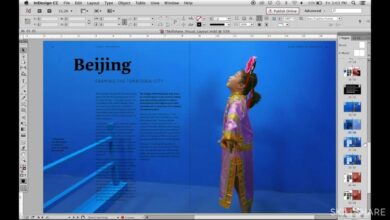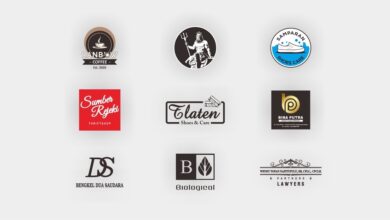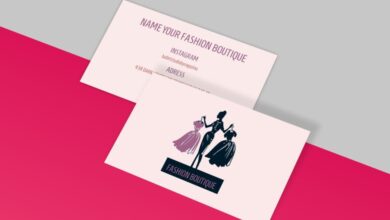
How to Design a Logo The Ultimate Guide
How to design a logo the ultimate guide for businesses and entrepreneurs – How to design a logo: the ultimate guide for businesses and entrepreneurs – sounds daunting, right? But it doesn’t have to be! Creating a killer logo is about more than just pretty pictures; it’s about crafting a visual representation of your brand’s soul. This guide will walk you through every step, from understanding your brand’s core values to mastering vector graphics, ensuring your logo resonates with your target audience and helps your business thrive.
We’ll cover everything from sketching and ideation to choosing the perfect font and color palette, and even how to get valuable feedback to perfect your design. Get ready to unleash your inner designer!
We’ll explore the crucial elements of effective logo design, delving into the psychology of color, the power of simplicity, and the importance of choosing the right typography. You’ll learn practical techniques for brainstorming ideas, overcoming creative blocks, and refining your sketches into polished, professional designs. We’ll also discuss the technical aspects, such as working with vector graphics and ensuring your logo scales perfectly across various platforms.
By the end, you’ll be confident in your ability to create a logo that truly represents your brand and captures the attention of your ideal customers.
Understanding Your Brand

Source: favpng.com
Before you even think about sketching a logo, you need a rock-solid understanding of your brand. A logo is simply a visual representation of your brand; it can’t magically create a successful business. A strong brand identity, however, informs every aspect of your logo design, ensuring it resonates with your target audience and effectively communicates your brand’s essence.
This section will explore how to define your brand’s core components.
Core Values and Mission of a Fictional Tech Startup
Let’s imagine a tech startup called “Synapse Solutions,” developing AI-powered educational tools. Their core values are innovation, accessibility, and impact. They believe education should be empowering and accessible to everyone, regardless of background or location. Their mission is to leverage AI to create personalized learning experiences that improve educational outcomes globally. This forms the foundation for their brand identity and informs every design decision, from the logo’s style to the color palette.
Target Audience for a New Line of Organic Skincare Products
“Bloom Botanicals” is launching a new line of organic skincare products. Their target audience is environmentally conscious millennials and Gen Z consumers aged 25-40, primarily women, who prioritize natural ingredients and sustainable practices. They are digitally savvy, value authenticity, and are willing to pay a premium for high-quality, ethically sourced products. Understanding this demographic is crucial in determining the logo’s aesthetic and messaging – it needs to feel both sophisticated and approachable.
Key Differentiators for a Hypothetical Restaurant
“The Cozy Kettle,” a new restaurant, aims to stand out in a crowded market. Their three key differentiators are: (1) Locally sourced, seasonal ingredients; (2) A warm, inviting atmosphere designed to foster community; and (3) A commitment to sustainable practices, minimizing waste and using eco-friendly packaging. These differentiators are the core selling points, and the logo should visually communicate these unique aspects.
For instance, the use of earthy tones might suggest the locally sourced ingredients, while a handwritten font could convey a sense of warmth and community.
Brand Personality Profile for a Sustainable Clothing Company
“Evergreen Threads,” a sustainable clothing company, possesses a brand personality that can be described as ethical, responsible, and stylish. They are committed to transparency and fair labor practices, using organic and recycled materials. They are also modern and fashion-forward, creating stylish and high-quality clothing. This blend of ethical responsibility and stylish design defines their brand’s personality, which should be reflected in their logo’s design choices – perhaps a combination of clean lines and natural imagery.
Brand Statements
To summarize, here are concise brand statements for each example:
- Synapse Solutions: Empowering global education through innovative and accessible AI-powered learning tools.
- Bloom Botanicals: Naturally beautiful skin, sustainably sourced.
- The Cozy Kettle: Locally sourced goodness, community warmth, sustainable dining.
- Evergreen Threads: Sustainable style, ethically made.
Logo Design Basics
Creating a memorable and effective logo is crucial for any business, acting as the visual cornerstone of your brand identity. A well-designed logo communicates your brand’s personality, values, and purpose at a glance, impacting everything from customer recognition to marketing materials. Understanding the fundamental principles of logo design is the first step to crafting a truly impactful visual representation.
Simplicity in Logo Design
Simplicity is paramount in logo design. A simple logo is easily recognizable, memorable, and versatile. It works well across various applications, from business cards to billboards, and remains effective even when scaled down or printed in low resolution. Overly complex logos can be confusing and difficult to recall, ultimately undermining their purpose. Think of the Nike swoosh or the Apple apple – both incredibly simple yet instantly recognizable worldwide.
These icons demonstrate the power of minimalist design, conveying brand identity with remarkable efficiency. The less cluttered your logo, the more impactful it will be.
Effective Use of Negative Space
Negative space, the area around and between the elements of a logo, is often overlooked but incredibly powerful. Clever use of negative space can create a secondary image within the logo, adding depth and meaning. The FedEx logo, for example, subtly incorporates an arrow between the letters “E” and “x,” symbolizing speed and delivery. The iconic “WWF” panda logo also expertly uses negative space to create the panda’s shape using only black and white, demonstrating how powerful negative space can be in conveying meaning.
Mastering negative space allows for the creation of visually stunning and memorable logos.
Color Psychology in Logo Design
Color psychology plays a significant role in logo design, influencing how viewers perceive your brand. Different colors evoke different emotions and associations. For instance, blue often represents trust and stability, making it a popular choice for corporate logos (think IBM or Facebook). Green suggests nature, growth, and freshness, frequently used by environmentally conscious companies. Red evokes passion, energy, and excitement, often seen in brands focused on food or entertainment.
Yellow conveys optimism and happiness, while black often signifies sophistication and elegance. Consider the specific emotions and associations you want to communicate when choosing your color palette. A well-chosen color palette will significantly impact the overall perception of your brand.
Comparison of Logo Styles
Several distinct logo styles exist, each with its own characteristics and applications. Minimalist logos prioritize simplicity and clean lines, focusing on a single, impactful element. Vintage logos often incorporate retro typography and imagery, evoking a sense of nostalgia and tradition. Modern logos are characterized by sleek lines, geometric shapes, and contemporary typography. The choice of style depends on your brand’s personality and target audience.
A tech startup might opt for a modern, geometric logo, while a bakery might prefer a more vintage or hand-drawn style. The key is to select a style that aligns perfectly with your brand’s overall aesthetic.
Logo Concepts for a Pet Grooming Service
Here are three distinct logo concepts for a fictional pet grooming service called “Pawsh Paws”:Concept 1: A minimalist logo featuring a stylized paw print, using a calming shade of blue and clean, sans-serif typography. The paw print is subtly designed to incorporate a heart shape within its form, conveying care and affection.Concept 2: A vintage-inspired logo featuring a playful illustration of a dog getting a bath, using muted pastel colors and a hand-drawn typeface.
The style evokes a sense of old-fashioned charm and trustworthiness.Concept 3: A modern logo with a sleek, geometric paw print composed of interconnected shapes, using a vibrant green and a modern, bold sans-serif font. The interconnected shapes symbolize community and connection. The color green represents freshness and health.
Sketching and Ideation
The process of sketching and ideation is crucial in logo design. It’s where your initial brand understanding translates into visual concepts. This stage allows for exploration and experimentation, laying the foundation for a strong and memorable logo. Don’t be afraid to let your creativity flow freely; even seemingly nonsensical doodles can spark brilliant ideas.
Brainstorming effectively involves generating a large quantity of ideas before refining them. The key is to avoid self-criticism during this initial phase. Quantity breeds quality, and even seemingly bad ideas can lead to unexpected breakthroughs. Techniques like mind mapping, mood boards, and association can help stimulate your creative process and overcome those inevitable creative blocks.
Logo Sketches for a Book Publishing House
Below are five unique sketches representing a book publishing house, each conveying a different aspect of the brand:
Sketch 1: An open book with a stylized rising sun behind it. The sun’s rays form a subtle halo around the book, symbolizing enlightenment and knowledge. The book itself is depicted simply, focusing on its shape and the implied pages. This design emphasizes the core function of a publishing house: disseminating knowledge and information.
So you’re crafting the ultimate guide on logo design for businesses and entrepreneurs? Awesome! Remember, a strong visual identity needs to be consistent across all platforms. That’s why, once you’ve nailed that perfect logo, think about how to promote it – check out this guide on getting it on with youtube to boost your brand visibility.
Then, get back to perfecting those design elements in your ultimate guide – it’s all about that cohesive brand experience!
Sketch 2: A stylized tree with leaves shaped like open books. The trunk is strong and rooted, representing stability and longevity, while the book-leaves signify the growth and diversity of the published works. This logo visually communicates a sense of established heritage and expanding literary horizons.
Sketch 3: An abstract design incorporating a quill pen and a flowing ribbon. The pen represents the craft of writing, while the ribbon suggests a sense of elegance and literary tradition. This logo appeals to a more sophisticated and classic audience, evoking a sense of refined taste and quality.
Sketch 4: A stack of books with a single book slightly elevated, representing a bestseller or a flagship title. The perspective is slightly angled, adding depth and visual interest. This logo is straightforward and directly communicates the business’s core product – books.
Sketch 5: A simple, bold typeface representing the publishing house’s name, interwoven with a subtle graphic element, such as a small, stylized bookmark or a simple line pattern. This logo focuses on strong typography and clean design, ideal for a modern and minimalist brand.
Overcoming Creative Blocks
Creative blocks are a common challenge in design. Several techniques can help overcome them. One effective strategy is to change your environment – a walk in nature or a change of scenery can often spark new ideas. Another is to engage in unrelated activities – listening to music, reading, or even doing household chores can surprisingly clear your mind and unlock fresh perspectives.
Finally, seeking inspiration from external sources, such as other logos, art, or nature, can provide valuable stimulus and help jumpstart the creative process.
Approaches to Sketching Logo Concepts
Three distinct approaches to sketching logos each have their own advantages and disadvantages:
Freehand Sketching: This method allows for spontaneity and fluidity. Advantages include speed and the ability to quickly explore multiple ideas. Disadvantages include potential lack of precision and difficulty in refining details.
Grid-Based Sketching: Using a grid provides structure and helps maintain consistency and proportion. Advantages include precise alignment and improved overall balance. Disadvantages include potential for stiffness and less freedom in exploring unconventional shapes.
Digital Sketching: Using a tablet and stylus allows for both speed and precision. Advantages include easy editing and the ability to experiment with color and texture early in the process. Disadvantages include potential reliance on technology and a less immediate, tactile experience.
Refining a Rough Sketch
Refining a rough sketch involves progressively adding detail and improving the overall composition. This might involve cleaning up lines, adjusting proportions, and exploring different color palettes. It’s a process of iterative improvement, where each refinement builds upon the previous one. Consider the visual weight, balance, and overall readability of the logo during this process. For instance, a rough sketch of a stylized tree might be refined by adding more detail to the leaves, refining the trunk’s lines, and experimenting with different shades of green and brown to create a more visually appealing and coherent image.
Choosing the Right Font and Typography

Source: entrepreneurshipsecret.com
Choosing the right font is crucial for a successful logo. It’s more than just picking a pretty typeface; the font you select directly impacts how your brand is perceived – conveying personality, professionalism, and memorability. The wrong font can undermine even the most brilliant design concept, while the right one can elevate it to iconic status. This section will explore the key considerations for selecting fonts that perfectly complement your brand identity.
Serif and Sans-Serif Fonts: A Comparison
Serif fonts, characterized by small decorative strokes (serifs) at the ends of letterforms, often project a sense of tradition, sophistication, and elegance. They are frequently used for luxury brands and publications that aim for a classic feel. Examples include Times New Roman, Garamond, and Georgia. Sans-serif fonts, lacking these serifs, tend to appear cleaner, more modern, and often more versatile.
They are commonly used in technology, minimalist designs, and situations where readability is paramount. Examples include Helvetica, Arial, and Open Sans. The choice between serif and sans-serif depends entirely on the desired brand aesthetic and target audience. For instance, a law firm might benefit from a serif font’s established feel, whereas a tech startup might opt for a sans-serif font’s modern appeal.
Font Choices for Different Brand Personalities
The ideal font choice is heavily influenced by the brand’s personality and target audience. A luxury brand, aiming for an air of exclusivity and prestige, might use a sophisticated serif font like Didot or a refined sans-serif like Bodoni. These fonts possess a timeless elegance that resonates with high-end consumers. Conversely, a playful children’s brand would benefit from a font that is fun, approachable, and easily legible.
Fonts like Bubblegum Sans or Comic Sans (though its overuse warrants caution) embody this playful aesthetic, engaging younger audiences with their lighthearted designs. The key is to ensure the font aligns seamlessly with the brand’s overall messaging and visual identity.
Font Readability and Legibility in Logo Design
Readability and legibility are paramount in logo design. A logo needs to be easily recognizable and understood at various sizes, from a business card to a billboard. Poorly chosen fonts can lead to illegibility, rendering the logo ineffective. Consider the kerning (spacing between letters) and tracking (spacing between words) – these factors significantly impact readability. A logo’s font should be easily deciphered even when reduced in size, ensuring it remains clear and impactful across different applications.
This is particularly important for logos that will be used in small formats, such as website favicons or app icons. Testing your logo at various sizes is crucial to ensure optimal readability.
Selecting Appropriate Font Pairings
Effective logo design often involves pairing two or more fonts to create visual harmony and hierarchy. The key is to choose fonts that complement each other, rather than clash. A common approach is to pair a serif and a sans-serif font, leveraging the contrasting characteristics of each. For example, a sophisticated serif font could be used for the main brand name, while a clean sans-serif font could be used for a tagline or secondary text.
The fonts should have a visual connection, perhaps sharing similar weights or x-heights (the height of lowercase letters), to maintain a cohesive feel. Experimentation is key; exploring different font pairings is crucial to finding the perfect combination. Avoid pairing fonts that are too similar or too drastically different, as this can create visual dissonance.
Logo Mock-up with Three Different Fonts
Imagine a logo for a coffee shop called “The Daily Grind”.We could use three fonts:
1. “The Daily Grind”
– A slightly condensed serif font like Playfair Display. This font provides a classic, elegant feel, fitting for a coffee shop aiming for a sophisticated image. The condensed style allows for a more compact logo without sacrificing readability.
2. “Coffee & More” (sub-heading)
-A lighter weight sans-serif font like Lato. This creates a contrast with the main title, offering a modern, clean feel for the additional services offered. The lighter weight prevents it from overwhelming the main title.
3. Small Icon Details (e.g., coffee bean graphic)
-A custom icon font or a stylized script font like Great Vibes, depending on the desired visual style. The custom font adds a unique and memorable element.
(Note: This is a textual description. A visual mock-up would be a graphic representation of this description).
Color Palette Selection and Application
Choosing the right color palette is crucial for a successful logo. Colors evoke emotions, influence perceptions, and ultimately, communicate your brand’s identity. A well-chosen palette can make your logo memorable and impactful, while a poorly chosen one can confuse or even repel potential customers. This section explores the psychology of color, provides examples across various industries, and guides you through creating harmonious and consistent palettes.
The Psychological Impact of Color
Color psychology is a fascinating field that studies how colors affect human behavior and emotions. Different colors carry different connotations and associations. For example, blue often represents trust and stability, while red evokes energy and excitement. Green suggests growth and nature, yellow signifies optimism and joy, and purple conveys luxury and creativity. Understanding these associations is key to selecting colors that align with your brand’s personality and target audience.
For instance, a financial institution might opt for a palette dominated by blues and greens to convey reliability and security, while a children’s toy company might use bright yellows, reds, and oranges to express fun and playfulness. The subtle nuances of color shades also play a role; a deep blue feels different from a light pastel blue.
Effective Color Palettes Across Industries
Different industries naturally lend themselves to specific color palettes. Technology companies often favor blues, grays, and silvers to convey innovation and sophistication. Think of the sleek, minimalist logos of tech giants like Apple and Google. Food and beverage brands frequently use warm colors like reds, oranges, and yellows to stimulate appetite and create a sense of warmth and comfort.
Consider the vibrant palettes of fast-food chains or the earthy tones used by organic food brands. The fashion industry embraces a wider spectrum, with color choices often reflecting current trends and the brand’s aesthetic. High-end fashion brands might utilize sophisticated jewel tones, while streetwear brands might employ bold, contrasting colors.
Creating a Harmonious Color Palette
Several methods can help create a visually appealing and harmonious color palette. One popular approach is using a color wheel to select colors that complement or contrast each other. Complementary colors (opposite each other on the wheel) create a high-contrast look, while analogous colors (adjacent to each other) offer a more subdued and harmonious feel. Triadic color schemes (using three colors evenly spaced on the wheel) provide a balanced and vibrant palette.
Another method involves using a dominant color, a secondary color for accent, and a neutral color for balance. Tools like Adobe Color or Coolors can assist in exploring various color combinations and generating palettes based on different schemes. Remember to consider the overall context of your logo and brand identity when selecting your colors.
Color Consistency Across Brand Applications, How to design a logo the ultimate guide for businesses and entrepreneurs
Maintaining color consistency across all brand applications is paramount. Your logo’s colors should be replicated consistently on your website, social media profiles, marketing materials, and packaging. This ensures brand recognition and strengthens brand identity. Creating a brand style guide that specifies the exact color codes (e.g., using hexadecimal codes like #007bff for a specific blue) is crucial for maintaining uniformity.
Inconsistency in color use can dilute your brand’s message and create a disjointed image.
Coffee Shop Color Palettes
Here are three different color palettes for a fictional coffee shop, “The Daily Grind,” each with a distinct feel:
| Palette 1: Warm & Inviting | Palette 2: Modern & Minimalist | Palette 3: Rustic & Earthy |
|
|
|
Logo Refinement and Digitalization

Source: com.au
Transforming your hand-drawn logo sketch into a polished, scalable digital design is crucial for its effective use across various platforms. This process involves refining your initial concept, converting it into a vector format, and ensuring its consistent appearance regardless of size or application. This stage bridges the gap between creative vision and practical implementation.The process of refining a logo sketch and translating it into a vector-based design involves several key steps.
It’s not simply about tracing; it’s about enhancing the design’s precision, consistency, and scalability. This ensures your logo looks sharp on a business card and equally impressive on a billboard.
Vector Graphics and Logo Creation
Using vector graphics is paramount for logo design. Unlike raster images (like JPEGs or PNGs) composed of pixels, vector graphics are built from mathematical equations defining lines, curves, and shapes. This means they can be scaled to any size without losing quality—a critical feature for a logo that needs to be used in various contexts, from tiny website favicons to large-scale printed materials.
A pixelated logo looks blurry when enlarged, while a vector logo remains crisp and clear.
Creating a Logo in a Vector Graphics Editor
Software like Adobe Illustrator is the industry standard for creating vector-based logos. The process typically involves:
- Importing the Sketch: Scan your sketch at a high resolution or take a clear photograph. Import it into Illustrator as a reference layer.
- Tracing and Refining: Use Illustrator’s tools (Pen Tool, Shape tools, etc.) to meticulously trace your sketch, creating vector shapes. This stage involves refining curves, adjusting proportions, and ensuring precise alignment of elements.
- Adding Details: Incorporate fine details, such as subtle gradients or textures, using Illustrator’s advanced features. Maintain a balance between detail and simplicity to ensure readability at smaller sizes.
- Color Application: Apply the chosen color palette, ensuring consistency and vibrancy. Experiment with different color modes (CMYK for print, RGB for screen) to achieve optimal results.
- Exporting: Export your logo in various formats (AI, EPS, SVG, PNG) for different applications. Ensure you export high-resolution versions for print and appropriately sized versions for web use.
Ensuring Scalability Across Different Sizes and Applications
A well-designed logo maintains its integrity regardless of size. To achieve this:
- Simplicity is Key: Avoid overly complex designs with excessive detail, which can become muddled when scaled down.
- Clean Lines and Shapes: Use sharp, well-defined lines and shapes that maintain their clarity at different resolutions.
- Consistent Stroke Weights: Maintain consistent stroke weights (thickness of lines) across all elements. Thin lines can disappear when scaled down.
- Test at Different Sizes: Always test your logo at various sizes (from very small to very large) to ensure it remains legible and visually appealing.
Refined Logo Example: “Apex Fitness”
Imagine a logo for a fictional fitness center called “Apex Fitness.” The refined vector logo incorporates a stylized mountain peak (representing the peak of fitness) formed by strong, bold lines. The peak is a gradient of deep blues and greens, symbolizing strength and vitality. Below the peak, the wordmark “Apex Fitness” is set in a custom sans-serif font, clean and modern, with a slightly bolder weight for “Apex.” The font color is a vibrant, energetic orange, contrasting with the cool mountain peak.
All elements are precisely aligned and perfectly scalable due to their vector nature. The mountain peak is constructed using multiple paths and gradient meshes in Illustrator, while the text is created using the type tool and adjusted for kerning and tracking. The entire logo is built using simple, clean shapes and lines, ensuring clarity at any size.
Testing and Iteration
Creating a logo isn’t a one-and-done process. It requires careful testing and refinement to ensure it resonates with your target audience and effectively communicates your brand’s identity. This iterative approach, involving feedback and revisions, is crucial for developing a truly impactful logo. Think of it as sculpting – you start with a rough idea and progressively refine it until you achieve the desired form.Gathering feedback on your logo designs is paramount.
Ignoring feedback can lead to a logo that fails to connect with your audience, ultimately hindering your brand’s success. Different perspectives offer valuable insights you might miss on your own. This stage isn’t about validating your initial vision, but about ensuring the logo effectively represents your brand to the outside world.
Feedback Gathering Methods
Several effective methods exist for collecting feedback on your logo designs. Online surveys allow for broad reach and anonymous responses, providing a diverse range of opinions. Focus groups offer more in-depth insights through direct interaction and discussion, enabling you to understand thewhy* behind the feedback. Presenting your designs to colleagues or trusted advisors can provide valuable early-stage critique and identify potential issues before wider dissemination.
Finally, A/B testing allows for direct comparison of different logo versions to determine which resonates more effectively with your target demographic.
The Importance of A/B Testing
A/B testing involves presenting two or more logo variations to a sample audience and tracking their responses. This allows for a data-driven approach to logo selection, minimizing subjective bias. For example, you might present one logo with a bolder typeface and another with a more delicate one, and track which version receives more positive feedback or higher click-through rates if used in online advertising.
This quantitative data provides a strong foundation for choosing the most effective logo. Remember, even subtle changes can significantly impact how a logo is perceived.
Identifying Potential Logo Issues
Before launching your logo, carefully analyze it for potential issues. Does it scale well to different sizes (from a business card to a billboard)? Is it easily recognizable and memorable? Does it look professional and consistent across different applications? Is it clear and understandable at a glance?
Does it avoid being too similar to competitors’ logos? Addressing these issues proactively prevents future problems and ensures a robust and effective brand identity.
Revising Based on Feedback
Once you’ve gathered feedback, carefully analyze it. Prioritize feedback based on its frequency and the severity of the identified issues. Some feedback might be subjective; focus on objective concerns like legibility or scalability. For example, if multiple respondents find a particular element confusing, that warrants attention. Don’t be afraid to iterate and refine based on constructive criticism.
The goal is to improve the logo’s effectiveness, not to please everyone.
Presenting Different Logo Versions for Client Review
Presenting multiple logo options to a client requires a clear and structured approach. Here’s how you can present different versions for review, highlighting key differences:
- Option A: Classic & Timeless
-Features a clean, minimalist design using a serif typeface and a subdued color palette. This option prioritizes sophistication and longevity. - Option B: Modern & Bold
-Utilizes a sans-serif typeface, vibrant colors, and a more dynamic design. This option projects a sense of innovation and energy. - Option C: Playful & Approachable
-Employs a hand-drawn style, softer colors, and a friendly font. This option creates a more casual and approachable brand image.
This structured approach ensures the client understands the design choices behind each option, facilitating a more informed decision. Remember to provide context and rationale for each design choice.
Conclusion: How To Design A Logo The Ultimate Guide For Businesses And Entrepreneurs
Designing a logo is a journey, not a race. Remember, it’s about creating a visual identity that’s both memorable and effective. By following the steps Artikeld in this guide, and by iterating and refining your designs based on feedback, you’ll be well on your way to crafting a logo that perfectly embodies your brand and sets you apart from the competition.
So go forth, experiment, and create a logo that you’re truly proud of – one that will help your business flourish for years to come! Happy designing!
Query Resolution
What file formats should I use for my logo?
Always provide vector files (like .AI, .EPS, or .SVG) for scalability. Include a high-resolution raster file (like .PNG or .JPG) for web use.
How much should I pay for a logo design?
Prices vary widely. Consider your budget and the designer’s experience. Cheap logos often lack professionalism. A good investment in a professional logo pays off in the long run.
How long does it take to design a logo?
The process can take anywhere from a few days to several weeks, depending on the complexity and the number of revisions.
Should I use a logo design template?
While tempting, using templates can result in a generic logo that doesn’t stand out. A custom-designed logo is always preferable.





